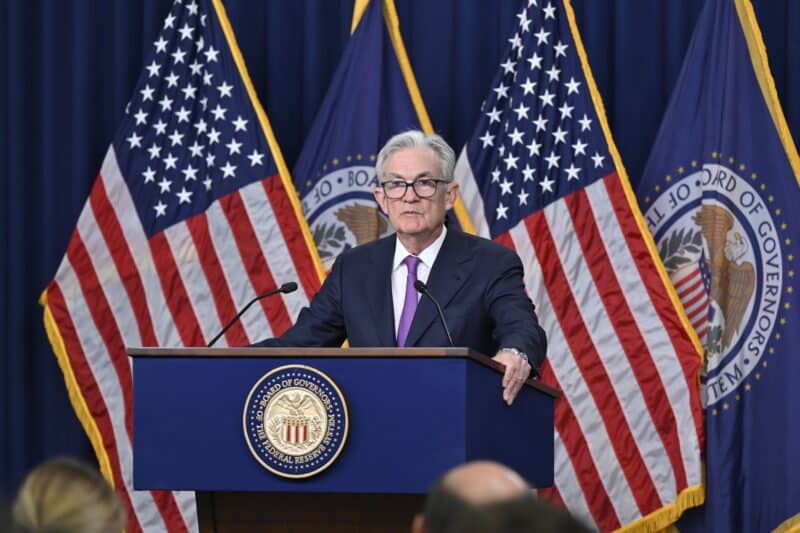We do not expect the FOMC, which is still a few meetings away from interest rate cuts, to significantly change its stance this week. However, we cannot rule out that volatility in the currency market will increase on Wednesday evening, especially if we see changes in the dot plot.
This week, the Federal Reserve will not change its policy, and the fed funds rate will be maintained in the range of 5.25–5.5%. In futures contracts, the probability of an interest rate cut at the March meeting is close to zero, and in May it is priced at no more than 10%, so markets do not expect a major change in forward guidance that could suggest an imminent cut. We share this view and expect the Fed to largely maintain its most recent rhetoric regarding the U.S. economy and interest rates. Attention would probably then focus on the revision of the dot plot, which would have a chance to hit newspaper headlines, and it would largely guide the behavior of the dollar and financial markets after Wednesday’s statement.
Mixed readings will not provoke changes in the bank’s attitude
Since the last FOMC meeting at the end of January, macroeconomic readings from the U.S. have been rather mixed. However, in our opinion, they were not weak enough to force a change in the Fed’s attitude. We are starting to see early signs of weakening spending. Both retail sales and the ISM and PMI indicators for services in February were weaker than consensus expected, as were January’s durable goods orders, which experienced the sharpest decline since the start of the COVID-19 pandemic. U.S. economic growth remains strong, but the Fed’s Atlanta nowcast for GDP has fallen from 4.2% in early February to 2.3% now.
Recent employment data is also disappointing. February’s non-agricultural employment data was solid, but revisions downward for January offset this. Monthly wage growth was the lowest in two years, the unemployment rate rose, and the number of vacancies consistently fell; all these changes, however, are coming from very good levels. The number of departures (3.39 million in January) has also dropped sharply recently and is at pre-pandemic levels for the first time since the peak at the beginning of 2022, which could indicate a potentially worse position for workers and weaker wage pressure.
Fed cautious due to persisting inflation
Resistance to a stronger turn towards a more lenient policy and another downward revision of the dot plot will likely result from the persistence of inflation seen in recent readings, which is still too high. We pay particular attention to signs of monthly core measure growth. The three-month annualized core rate – our preferred measure of price pressure – rose again in February above the 4% level and is now at its highest level in nine months (4.2%).
During his semi-annual report to Congress at the beginning of March, FOMC Chairman Jerome Powell confirmed that the Fed is likely to start cutting interest rates at “some point this year,” but warned that progress towards achieving 2% inflation is not certain.
We believe that on Wednesday Powell will largely repeat his comments, and the data published in the meantime should not cause a change in rhetoric. He will choose his words carefully and will once again let the markets understand that interest rate cuts are coming, but he will not fuel excessive bets for rapid cuts, as happened in December. He will likely repeat the sentence he said before Congress: “The risks threatening the achievement of our employment and inflation targets are fading”. However, Fed officials undoubtedly want to see more evidence of a persistent downward trend in inflation, especially PCE, before they commit to rapid cuts, and Powell may highlight this during his press conference.
New dot plot a risk for the market
If the messages in the FOMC statement and during Powell’s press conference do not change too much, the bank’s interest rate projections (dot plot) and economic projections will be key for the dollar’s reaction. In December, FOMC members expected three 25 bp cuts in 2024 and four more in 2025. We do not expect changes in median forecasts and believe that the Fed does not need to guide the markets in a particular direction.
Futures contracts currently price in nearly 75 bp of U.S. interest rate cuts this year, which coincides with the December Fed dot plot.
While we do not anticipate a downward revision of median inflation projections, we would not be too surprised to see a small change in the 2024 dot plot and a reduction in the forecasted number of cuts to two due to persistent inflation concerns. This would be positive for the dollar in the short term – not only would it move the expected date of the first interest rate cut from June to July or September, but it could also raise the implied fed funds rate at the end of the year. We believe this represents the biggest risk for the currency market in relation to Wednesday’s statement and could lower the EUR/USD rate to mid-February lows. Such a turn of events, in addition to automatically raising the USD/PLN rate, could also put pressure on the Zloty.
The FOMC policy decision will be announced on Wednesday (March 20th) at 7:00 p.m., and Chairman Powell’s press conference will start 30 minutes later.
Author: Matthew Ryan, CFA – Head of Market Analyzes at Ebury
